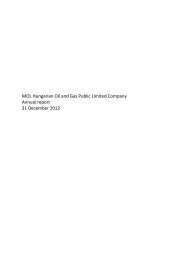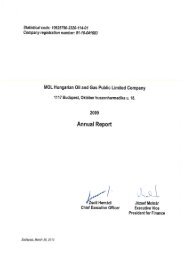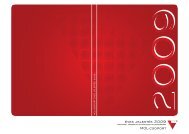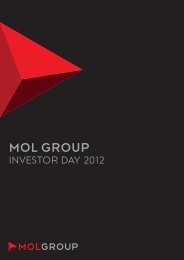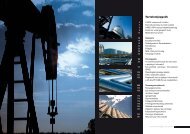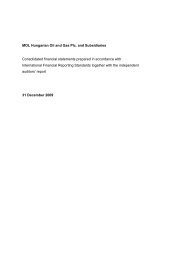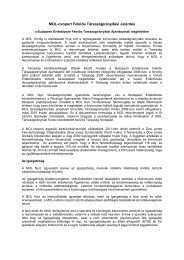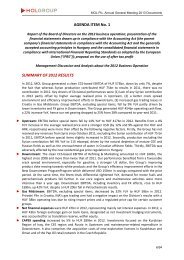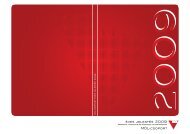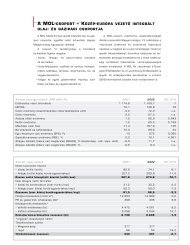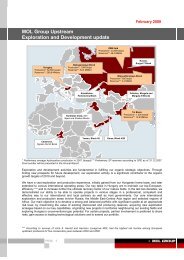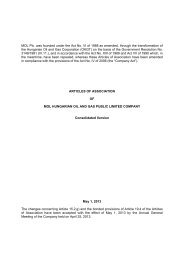MOL GROUP Annual Report
MOL GROUP Annual Report
MOL GROUP Annual Report
- No tags were found...
You also want an ePaper? Increase the reach of your titles
YUMPU automatically turns print PDFs into web optimized ePapers that Google loves.
The Group may use cross currency swaps to adjust the currency mix of the debt portfolio. As of 31 December 2010 and 2009,there were no open cross currency transactions.The Group has two long-term international gas transit agreements (expiring in 2017 and 2019) under which consideration iscalculated in SDR. The contractual provisions prescribing price calculation in SDR have been identified as a SDR/USD swap,being an embedded derivative under IAS 39, as the Group considers USD price setting to be closely related to the hostcontract. This derivative has been separated from the host contract and designated as a cash flow hedge to the host gastransit contract. The fair value of the embedded SDR derivative is a net receivable of HUF 4,116 million (HUF 3,704 millionnet of deferred tax) as of 31 December 2010 (see Note 12). The corresponding figure as of 31 December 2009 was HUF 4,139million net receivable (HUF 3,353 million net of deferred tax). The decrease in the fair value of this instrument has beendebited to equity.INA has concluded certain long- term contracts on gas and crude- oil storage and transport, what contain embeddedderivatives as defined by IAS 39. These derivatives has been separated from the host contracts and designated as fair valuehedge to the host gas and crude- oil contracts. The fair value of the embedded derivatives is a net receivable of HUF 184million as of 31 December 2010 (see Note 12 and Note 15). The corresponding figure as of 31 December 2009 was HUF 1,097million net receivable.The Group classifies its forward exchange contracts and currency exchange options either as fair value hedges, in case ofdebts, either as cash-flow hedges in case a designated hedging relationship exist or as stand-alone derivatives and carriesthem at fair values.As of 31 December 2010 and 2009 the fair value of open foreign exchange forward transactions was a net of receivable ofHUF 8 million and HUF 65 million (see Note 15), respectively.Interest rate risk managementAs an energy company, <strong>MOL</strong> has limited interest rate exposure. The ratio of fix/floating interest debt is determined by theBoard of Directors on the basis of the suggestion of Group Risk Management from time to time, based on international bestpractice.As result of the 750M EUR Bond transaction in 2005, 750M EUR Bond transaction in 2010 and 5,051 million Hungarian retailbond transaction also in 2010, the fixed portion of the total debt increased substantially. As of 31 December 2010 and 2009,32.6% and 17.7% of the Group’s debt was at fixed rates respectively.The Group may use interest rate swaps to manage the relative level of its exposure to cash flow interest rate risk associatedwith floating interest-bearing borrowings.As of 31 December 2010 and 2009, there was no open interest rate swap transaction.Sensitivity analysis for key exposuresIn line with the international benchmark, Group Risk Management prepares sensitivity analysis. According to the FinancialRisk Management Model, the key sensitivities are the following:Effect on profit from operations2010HUF billion2009HUF billion(including INA)(excluding INA)Brent crude oil price (change by +/- 5 USD/bbl; with fixed crack spreads and petrochemical margin)Refining and Marketing + / - 4.8 + / - 2.0Exploration and Production +15.8 / - 15.0 + 3.8 / - 4.2Petrochemical - / + 5.4 - / + 3.5Crack spread (change by +/- 10 USD/t)Refining and Marketing + / - 42.3 + / - 33.2Exploration and Production + 5.3 / - 3.1 + 0.7 / - 0.8Integrated petrochemical margin (change by +/- 10 EUR/t)Petrochemical + / - 3.0 + / - 3.1Exchange rates (change by +/- 10 HUF/USD; with fixed crack spreads)Refining and Marketing + / - 16.6 + / - 11.6Exploration and Production + 15.3 / - 15.4 + 5.9 / -6.1Petrochemical - / + 13.1 - / + 9.6Exchange rates (change by +/- 10 HUF/EUR; with fixed crack spreads /targeted petrochemical margin)Refining and Marketing + / - 3.6 + / - 2.6Petrochemical + / - 10.6 + / - 11.4Retail + / - 0.2 + / - 0.5Other ExposuresCredit riskThe Group provides a variety of customers with products and services, none of whom, based on volume and creditworthiness,present significant credit risk. Group procedures ensure that sales are made to customers with appropriate credit history anddo not exceed an acceptable credit exposure limit.Customers are allocated to 12 segments in order to provide better transparency and to achieve more conscious diversification.The different characteristics of the segments support the mitigation of credit risk.For segments with higher risk profile the ratio of secured credit limits is also higher. Credit insurance, collateral, bankguarantee, letter of credit and lien are the most preferred insurance types.As a result of being a major player in the Central-Eastern European region, approximately 70% of our customers is situated inthat region; nevertheless our customer portfolio is very diversified from geographical point of view.Notes to the financialstatementsGroup procedures ensure that sales are made to customers with appropriate credit history and do not exceed an acceptablecredit exposure limit.Individual credit limits are calculated and defined after external and internal assessment of customers. Information onexisting and possible customers is gathered from well-known and reliable Credit Agencies. Internal assessment shall be doneon the basis of information obtained, where individual credit limits are calculated by pre-defined algorithms. The internalsemi-automated assessment shall be considered as an international best practice with conservative credit managementapproach.Sophisticated software solutions (SAP, CRM, Endur) ensure online monitoring of credit exposures, breach and expiry ofcredit limits and also overdue receivables. When such credit situations occur, shipments shall be blocked. Decisions on theunblocking of the shipments shall be made by authorized managers both on Financial and on Business side. The level of theManagerial decisions is regulated in Group policies.148 <strong>MOL</strong> Group annual report 2010 149



